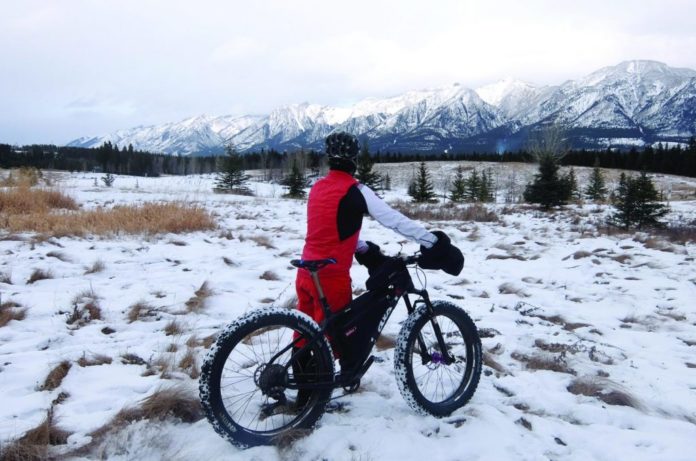It wasn’t long ago that riding a two-wheeler in the dead of winter was seen as a crazy thing to do. Back then, only those die-hard mountain bikers or commuters would tackle the winter weather at its worst with home-made studded tires and bundles of winter clothing.
Look around now in die hard cycling communities and you will find cyclists of all ages, shapes, and sizes out riding in all conditions safely and happily. About 5 years ago the fat bike craze started in Alberta and was made very popular in Canmore by a group of avid mountain bikers looking to ride the trails 12 months of the year. It was only 5 years ago that two or three brands of fat bike existed and only a few models to choose from that were all mainly made of steel. Now almost every major bicycle manufacturer has a line up of bikes in aluminum or carbon, and some even come with suspension ranging in price from $1,000 to well over $8,000.
 What has made Canmore and the Bow Valley such an amazing place for fat biking is not really a secret. It’s the simple combination of an active community combined with a trail system that does not discriminate against seasonal use. Most of the trails in the area, even after a good snowfall, are accessible and packed down by a multitude of user groups. Dog walkers, runners, snowshoers, hikers, and fat bikers all lend a hand in packing down the snow so each can benefit from the collective use.
What has made Canmore and the Bow Valley such an amazing place for fat biking is not really a secret. It’s the simple combination of an active community combined with a trail system that does not discriminate against seasonal use. Most of the trails in the area, even after a good snowfall, are accessible and packed down by a multitude of user groups. Dog walkers, runners, snowshoers, hikers, and fat bikers all lend a hand in packing down the snow so each can benefit from the collective use.
Fat bikes have exploded in the bike industry and have been embraced in many places around the world, including some places that don’t even get snow. For example, coastal areas use them on beaches and communities located in the desert use them on the sand. All the uses have one main thing in common and that’s the float that comes from the oversized tires. Some tires are 4 inches wide, while others are 5 inches wide, with a variety of tread patterns and even studs for ice. The tires are really the star of the fat bike concept and are in some cases the most expensive part of the bike. Aside from the tires, the rims are much wider than a standard mountain bike and the frames are built around the wide rim and tire combination to allow for frame clearance.
Fat biking takes on many forms depending on where you go. For example, in the Midwest fat bikes are used on lakes and wide-open trails that get groomed. In northern parts of Canada and the U.S. the bikes are used on snowmobile trail networks and frozen roads. In the Bow Valley fat bikes are used for riding the same single-track trails we ride on in the summer. This is all made possible because our winter snowfall is very manageable and doesn’t require machine grooming to make it rideable.
What do you need to get rolling on a fat bike? Renting is a great start; there are a few local bike shops that offer daily and hourly rentals as well as scheduled weekly group rides. Testing out your fitness and skills in a variety of temperatures and snow conditions, along with advice from fellow fat bikers will help you choose the right bike and gear if purchasing one is in your future.
On the clothing side, it’s pretty much like dressing for cross-country skiing, since it is also a higher intensity sport that makes you break a good sweat as soon as the terrain kicks up. Warm gloves and boots are key, along with a good layering system. Make sure to bring a snack and something to stay hydrated if you plan on going out for a longer ride. A bike helmet with a beanie under it works great or a down hill ski helmet can also do the trick on colder days to keep your head well protected.
Words of advice for those looking to try out fat biking for the first time: don’t think of fat biking as mountain biking on snow. It’s a very different and sometimes extremely complex sport to master. With temperatures, snow conditions, and level of preparedness, there are so many factors that need to be taken into consideration that ultimately will influence your experience, but like anything in time you become familiar with those variables and learn how to make it enjoyable every single time.









